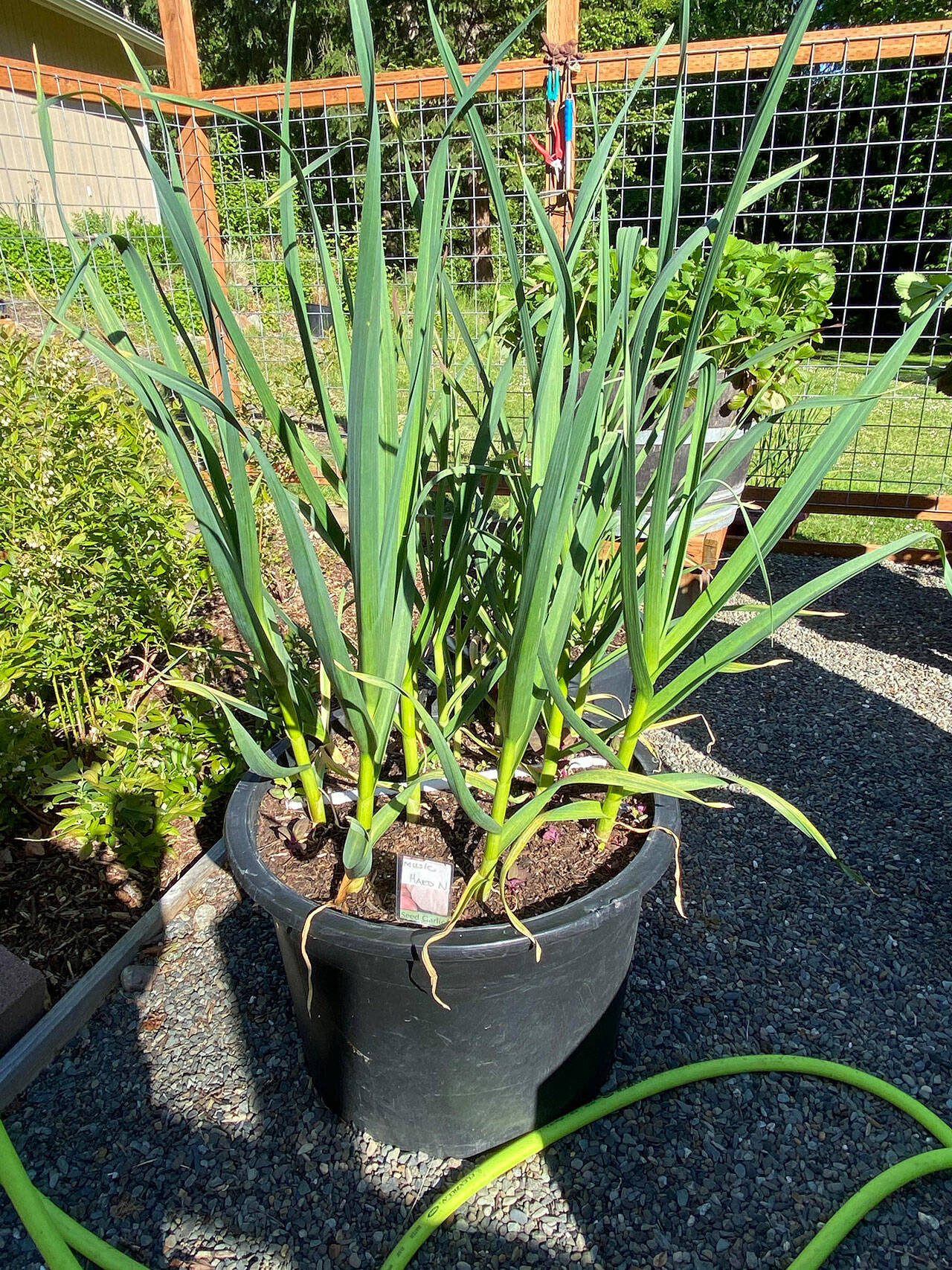Growing garlic on the Olympic Peninsula is right up there with growing lavender and dahlias, and fall is the time to plant. So, the question “Can I grow garlic in containers?” is not only relevant but also timely. October is an ideal time for planting garlic, whether in the ground or in a container.
There are two subspecies of garlic (Allium sativum): softneck and hardneck. Softneck garlic is characterized by many layers of cloves in the bulb and a soft, pliable group of leaves at the top of the bulb. Softnecks are difficult to peel but they store for a long time — up to one year. They typically have 12 to 20 cloves per bulb and taste either fiery hot or mild, depending on the variety.
Hardneck, or topsetting, garlic has only one layer of cloves that surrounds a woody flower stalk. Hardnecks are easy to peel, but store for only three to six months. They produce four to 10 cloves, and generally are more highly flavored than the softnecks.
There are more than 100 named varieties of garlic available, largely through catalogs (check local nurseries for a few varieties of garlic bulbs for planting). See the sidebar for examples of softneck and hardneck varieties; try several. It is important to buy certified planting stock, not supermarket garlic, so you don’t introduce viruses or disease into your garden.
When choosing a pot or container, it should be at least 8 inches deep, ideally a little deeper. Your container should be large enough to space garlic cloves around 3-4 inches apart from one another. In a container with a surface area of 1 square foot you could plant at least 12 cloves.
Do not use a container that was used to grow onions, garlic, leeks, or shallots in the last two years. Garlic is susceptible to the same diseases, so crop rotation is important. Any good, free-draining potting mix with the addition of some compost should work well. Sandy loams with organic matter are ideal. Choose a site, or several sites, for the containers that receives six or more hours of sunlight a day.
Before planting, break apart the garlic bulb into individual cloves; this is called “clove popping.” Carefully slice through the layers of bulb wrappers with your fingernail and then put gentle pressure on the cloves until they separate from the bulb. It’s important not to bruise the cloves as you separate them. Always discard soft, damaged or moldy bulbs.
Plant with preference to the largest cloves; the bigger cloves will give you the most generous bulbs nine months later when you harvest. When planting in a container, plant the cloves 2 inches deep (pointed end up), and 3-4 inches apart.
Add mulch to the newly planted garlic. The mulch will moderate soil moisture and temperature and keep down weeds. The garlic will probably sprout in the fall, but don’t worry, it will survive the winter. Garlic planted in fall will be ready to harvest the following summer.
After the leaves on the lower third of the plant have turned yellow, the garlic is ready to harvest. This usually occurs during late June and mid-July, depending on the growing climate and the garlic variety planted. Reduce water before harvesting the garlic.
Be careful not to damage the bulb during harvest, as any wounds or bruises make the bulb more susceptible to disease and deterioration during storage. Use a trowel or fork to gently loosen the soil under the bulb.
Gently brush soil from the bulb and its roots. Place the garlic with the tops intact in a dry, cool, well-ventilated place to cure. After several weeks, the garlic will be cured and the roots and foliage can be removed (leave about one inch of stem). After curing, the garlic will keep for several months or more.
Susan Kalmar is a WSU Clallam County Master Gardener.
2022 Master Gardener Calendars
Back by popular demand, the beautiful Master Gardener calendar is back for 2022! Along with outstanding, full-page, color photography, this year’s calendar features tons of gardening information, including the sought-after chart, “Recommended Planting Times and Vegetable Varieties for the North Olympic Peninsula.”
The 2022 calendar is on sale for $5 per copy at the following locations:
• WSU Extension office, Clallam County Courthouse, 223 E. Fourth St., Port Angeles; 9 a.m.-2 p.m., Mondays-Thursdays
Note: Because the office is not fully staffed, please contact Rhonda Raymond at 360-417-2279 or rraymond@co.clallam.wa.us to set up an appointment.
• Woodcock Demonstration Garden, 2711 Woodcock Road, Sequim; 10 a.m.-noon on Thursdays and whenever Master Gardener events are being held.



